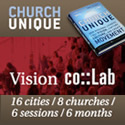Mixing Technology and Ministry: Don’t Make These Mistakes!
- Posted by: Todd
- Posted on: Wed, July 27, 2005
- Viewed 200
- (3) comments so far
My Pastor, Ed Young, Jr., of Fellowship Church, sends out a "Leadership Uncensored" newsletter for people subscribed to CreativePastors.com. In the latest issue, he gave five practical tips on using media & technology.
I've listed his 5 points and brief explanations below in quote boxes. I've then added my own thoughts - from the techie side of the fence - as I think this is really great stuff and deserves some additional dialogue.
1. Who are the toys really for? When you are considering new technology and media purchases, ask yourself this question: Are they really going to help communicate God's unchanging truth? Or are they just toys?
Ed's point is dead-on target - and he's really aiming his criticism, rightfully so, at us techies. We're guilty of always wanting the latest and greatest technology, even when it's not something we need. When you stop and think about it, many pastors get frustrated because there are those of us who are always complaining about what we don't have.
This causes two big problems: 1) It lessens your credibility as a solutionist; 2) Techies have, for the most part, earned the reputation of being unsatisfied with what we have. Instead of using what we do have to the best of our ability and - here's the kicker - documenting and proposing what kind of changes can be made to meet the vision of the leadership, we simply say "we can't do that" or "we need more budget for better equipment".
By opening up an honest communication with our Pastors about what's possible, what's probable and what's impractical, we can help our leadership understand that sometimes we really do need better equipment, because it solves a problem, not because it's the latest widget.
2. Put people in place first. When you set out on the technology path, don't start with equipment needs. First go out and find people you can trust to help you make the right decisions. Whether they are staff, volunteers, partners or consultants, make sure they have the right training and experience to give you quality information and advice on wise technology purchases.
HELLO! There is such a huge amount of truth in this statement! I'd even add to Ed's suggestion by saying hire experts to check your staff and volunteers out! Training who you have is always a good idea, and getting an outside perspective is usually very beneficial. By investing in our people first, we can make sure that when new technology is added, we have the talent and expertise to utilize it fully.
3. Make the investment to get it right. Technical mistakes can turn a worship experience into nothing more than a performance evaluation. When you use media and technology to fuel your weekend services, make sure your church can commit the resources to make it a seamless experience. Spend the money to get equipment that will make it look professional. And then, set aside time for your staff to practice and rehearse.
Two HUGE statements are in that short paragraph: 1) Don't spend your money over and over again poorly; 2) Set aside time to practice and rehearse. I'll tackle these one at a time.
Don't Buy It Three Times is an article I wrote (it's in my Subscriber's only section) that takes the famous Don Davis quote and expounds on it. This is worth a read!
When Ed says "take time to practice and rehearse", he's not talking about 30 minutes before service. Look, even if you're a porta-church without a permanent facility, your team can still practice! How? By planning ahead! If your team has a copy of the songs, sermon outline, order of service, or any other pre-planned items, it's possible for each person to practice on their own.
For example, if your graphics person has a CD with the songs that will be used on the upcoming weekend, they can ensure the song lyrics are typed the way the song is sung (and not just how the CCLI Song Select database or worship software thinks it should look), the graphics fit the background and that the sermon notes and outline are ready and spellchecked. These are minimal things that any size church can do.
If you're really fortunate and have a Creative Planning Team, then the practice becomes even easier to delegate.
4. Be curious. You don't need to become a technical expert on every piece of equipment, but it is worth the time to educate yourself on the basics. Get a general grasp on how the different elements of lighting, sound and camera work come together to create a meaningful service.
I often tell the story of how I would ask my pastor or music minister or whoever was asking for a video to come in during the planning meetings and editing sessions. The first-hand experience of simply watching how long it takes to create a polished 3 minute video is incredibly helpful for them. Once they understand the time factor involved with quality media, one of two things should happen: 1) They start giving you more time to do a project when they first ask for your help and/or 2) they let you hire the right people and get the right equipment to meet the perceived expectation in their time frame.
One last thought about this point: it's not the Pastor's job to know how to do what we do. Chances are, they're not going to be "techies" like us. I submit that it is our responsibility to translate what we do and speak their lingo instead of Tech-ese.
5. Let your vision determine your direction. Too often, churches buy technology and media equipment that takes them in a different direction from their vision. The direction you go should be determined by the vision, not the technology. Ask yourself where you are and where you want to go. Then make a plan to get there. That way your media and technology decisions will mirror and underscore the direction the church is going.
WOW. The best statement of the five! When your pastor has the freedom and support to ask "what's possible for my vision" and can partner with you to create a plan to get there, you're on the right track. Unfortunately, many (most?) church techs don't have a strong, positive relationship with their pastors. Indeed, I believe that the vast majority of pastors live in frustration when in comes to communicating their expectations with people who typically can't speak plainly when it comes to high-tech. Worse, while they may personally like their tech director, the frustration level these pastors experience leads them to either stop asking for media support or have an almost adversarial relationship with techs that, in their mind, can't relate to them.
Along with this line of thinking comes my famous quote: "Don't Xerox a Mega Church!"
I'm all for copying something that's working well, but only when it fits the context of what we do, who we are, how we work and where we worship. No two churches are totally alike. In the same way, it's not smart to try and use the same technology or adopt the exact procedures of a large, media-savvy church. Instead, develop the trust, open communications and ensure the vision of leading your Media ministry is in synch with the vision of your church leadership. By doing so, you'll know that the implementation of technology is appropriate for your church.
Well said, Anthony! Anyone have any additional thoughts?
My blogging friend Anthony D. Coppedge had a great post recently that discusses the comments of his pastor, Ed Young, from Fellowship Church in Dallas on the issues of technology in the church. These are some great tips for you and your church when you consider the impact and use of technology in your ministry. Anthony writes…
Comments
if you want a Globally Recognized Avatar (the images next to your profile) get them here. Once you sign up, they will displayed on any website that supports them.






Bernie Dehler on Thu, July 28, 2005
Article asks:
“Who are the toys really for?”
“Toys” should be for fulfilling one’s mission, not to play with. Mission comes first, then the technology to support it. Someone who puts technology first is lost… lost focus of what they should be doing…
...Bernie
http://freegoodnews.blogspot.com/
Scott Spierling on Tue, August 02, 2005
When deciding on tech purchases as related to church vision, don’t just include the Senior Pastor, include all staff that may want to use the equipment. We learned this the hard way when we purchased our first video projection system. We made it clear to the Senior Pastor that even though we would have three screens, the same image would be projected on all screens; the equipment would not allow three separate images. The Senior Pastor was fine with this and we purchased and installed the equipment. Less than three weeks after the intallation, one of our other pastors was preaching and came up with a really creative presentation that requied different images on diferent screens. We figured out a way to do it but it wasn’t pretty and soon we were budgeting for our second try at a video projection system.
Keith on Tue, August 02, 2005
The Apostle Paul said in the Word,“Be all things to all men, so that we can win them.“paraphrased) I’ve always felt the if we “use everchanging Methods to share the Neverchanging gospel we can change our world. Tecnology is just one of those methods. Good artical and comments.
Page 1 of 1 pages
Post a Comment